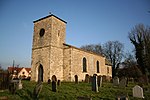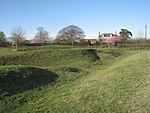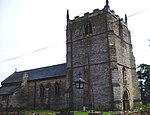Willoughton Priory
Lincolnshire building and structure stubsMonasteries in LincolnshireUnited Kingdom Christian monastery stubsUse British English from May 2024

Willoughton Priory was an alien priory (priory controlled by an overseas religious house) in Willoughton, Lincolnshire, England. It was built some time during the 12th century when Empress Maud granted the priory to the Benedictine Abbey of St. Nicholas in Angers, France. The property was confiscated by King Henry VI in 1441 and was given to King's College, Cambridge. There is no structure remaining, but there are earthworks showing where the priory once stood.
Excerpt from the Wikipedia article Willoughton Priory (License: CC BY-SA 3.0, Authors, Images).Willoughton Priory
Church Street, West Lindsey
Geographical coordinates (GPS) Address Nearby Places Show on map
Geographical coordinates (GPS)
| Latitude | Longitude |
|---|---|
| N 53.427548 ° | E -0.598378 ° |
Address
Church Street
DN21 5SD West Lindsey
England, United Kingdom
Open on Google Maps










